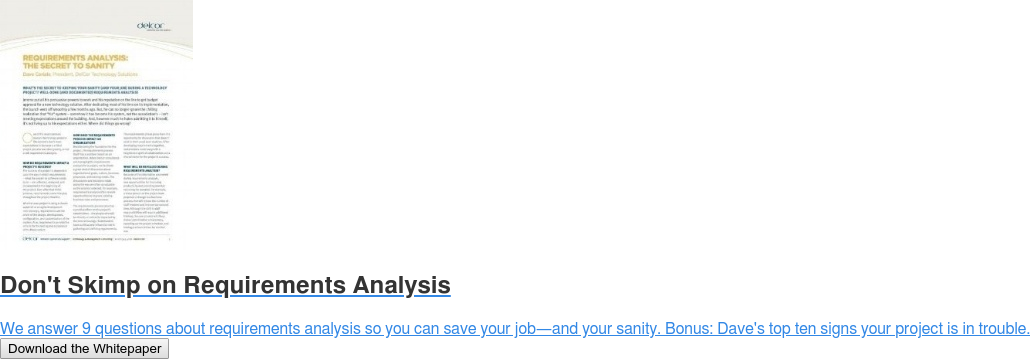What happens when you’ve got a reputation for getting things done? You’re ‘rewarded’ by being put in charge of challenging projects. Has it happened to you? Maybe you’re the membership director who’s tasked with managing the selection and implementation of a new association management system (AMS) or the communications director who’s overseeing a website redesign.
Managing a successful technology project definitely has its rewards:
- It looks good on your resume—which will come in handy when you’ve decided you’ve had enough 60-hour weeks.
- It provides the opportunity to improve your leadership, management, and communication skills.
- It gives you the chance to develop project management skills. And, boy, are you going to need those!
But, there’s a dark side to DIY project management. You could spend 50% of your time managing the project, even more during periods of peak activity. When do you find time to handle the other responsibilities on your plate?
Then there’s the knowledge gap. Projects can go off the rails so easily when you haven’t had practice managing them. You can find tools and templates online at The Project Management Institute or with some expert-level Googling, but it’s still a challenging responsibility to take on a technology project alone without a trusty guide—like a PMP-certified DelCor project manager.
Download our guide on Requirements Analysis to make sure your team's projects succeed.
If you don’t have the resources to bring in outside help, here’s some advice for managing a technology project.

I dub thee: ‘project manager’
First things first: the project charter. The charter is the tool used to formally authorize a project to begin. It establishes the project’s purpose, high-level scope, parameters, and resources. Once approved by the project sponsor, the charter authorizes you, the project manager, to manage the project. It shows your organization’s commitment to the project as well as its commitment to provide the resources required to successfully complete it.
As the project manager, you may be responsible for writing the project charter. Or, the project sponsor or the staff with the ‘business need’ for the project writes the charter. If that’s the case, insert yourself early in your role as project manager to review and contribute to the charter draft. The more intimately you are involved at the start, the better positioned you will be to help ensure the project achieves desired outcomes.
The project’s advocate: the executive sponsor
Who is the project sponsor? The sponsor is the project advocate who approves the charter and authorizes resources and funding for the project. The sponsor is on the project escalation path—they step in when issues escalate. For example, they may be called upon to make difficult decisions, remove internal obstacles, hold team members accountable for their responsibilities, or approve changes to scope, time, or budget.
An executive-level sponsor is best since they can ensure top-level support, especially for a complex, cross-departmental project, such as the implementation of a new AMS. Complex projects that go forward without the authorization of an executive sponsor are more likely to fail.
The role of the project charter
Besides authorizing the project, the charter sets the guiding principles for the project and for the project manager. Developing the project charter provides the opportunity to confirm that project objectives are aligned with your organizational strategy.
The charter becomes your touchstone—you’ll refer back to it throughout the project when making decisions. For example, if several months into the project, a department head wants to add something to the project scope, you can remind her that the scope agreed upon by all key stakeholders does not include that requirement. In fact, the charter can establish exclusions to scope at the outset, for added clarity, which may save the team from retreading those questions down the line.
The elements of a project charter
The project charter usually includes these components:
- Description and scope of the project: what the project includes and what it doesn’t
- Business case (justification) for the project: the problem(s) it will solve
- Objectives: what the final project deliverable or outcome is expected to do
- Project requirements: a high-level description of must-haves
- Performance metrics: how you will measure the project’s success
- Identification of key stakeholders: to include the sponsor, project manager, and the project team, along with their roles and responsibilities
- Timeframe: to include major milestones
- Assumptions: factors presumed true that may influence the project’s processes or outcomes, such as the assumption that the project’s human resources have the skills necessary to complete data conversion
- Constraints: limitations placed on the project such as scope, schedule, or budget—together known as the ‘triple constraints’
- High-level risks: for example, project requirements may change if new legislation is passed
- High-level budget: a summary of the budget allotted for the project
While the project charter must be approved by the project sponsor or initiator, it will serve the project well to have other key stakeholders sign the charter as well. With stakeholder approval, months from now you can point to the project responsibilities a stakeholder has agreed to for his staff, such as participating in user acceptance testing.
Putting your project charter together.
There is no one-size-fits-all standard. A charter can range from one page to tens of pages to multiple documents, as larger and lengthier projects may require more detail. In some cases, a project could be initiated via email from the sponsor, outlining all the necessary components.
Start by establishing a simple template that works for your organization’s needs. A consistent template across projects helps stakeholders become accustomed to the elements of a charter. Over time, the charter can evolve to include additional details that have contributed to project success.
The important thing is that the charter does its job of initiating the project, setting the terms that the stakeholders agree to, and providing authorization for the project to move forward with you as its assigned project manager.
If you’ve never worked with a project charter before, at first impression, it may seem like too much fuss. But a charter ensures that everyone uses the same playbook to work toward common goals. Don’t start a project without one!
As noted, requirements play a major role in the project charter—and beyond. Take a deep dive into understanding how to uncover and document them. Download our free whitepaper, Requirements Analysis: The Secret to Sanity, to learn more.

